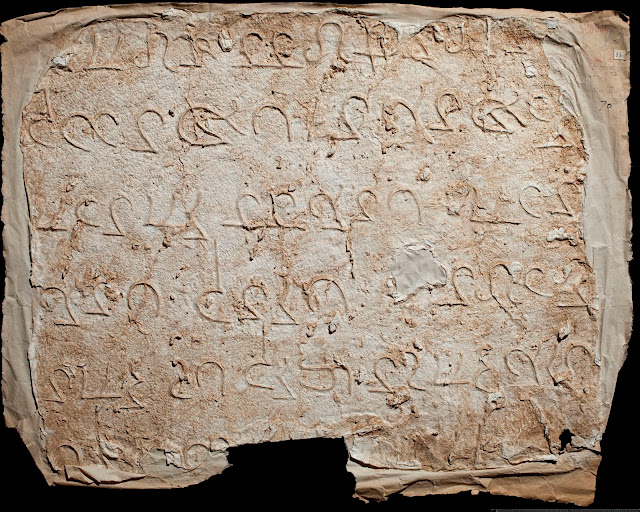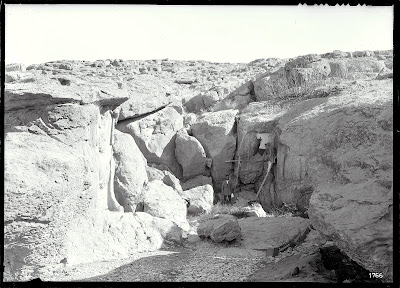This second of two blog posts was written by Xavier Courouble, cataloger of the collections of Antoin Sevruguin Photographs and the Ernst Herzfeld Papers at Freer Sackler Archives, Smithsonian Institution. This post explores the presence of individuals of African descent at religious events in Qajar Iran.
 |
Groups of Attendants at a Religious Gathering.
Antoin Sevruguin (d. 1933). Albumen print taken before 1896. Myron Bement Smith Collection of Sevruguin Photographs. Freer Gallery of Art and Arthur M. Sackler Gallery Archives. Smithsonian Institution, Washington D.C.
(FSA A2011.03 B.09). |
Africans in Shiite Rituals during the Qajar Dynasty
The three photographs, taken by Antoin Sevruguin at the beginning of the twentieth century, depict a private performance and a large public procession, annually held during the first ten days of
Moharram, the first month of the Islamic calendar. They are part of the mourning ceremonies of
Moharram, commemorating the martyrdom of Imam Hosayn at Karbala in 61 AH/680 CE and reaching their climax on the tenth day of the month (
Ashura). Expression of grief during public mourning processions are accompanied by assemblies held in buildings erected for the purpose (
hosayniyas or
takias), as well as in mosques and private houses. At these assemblies, called
rowzeh-khani, professional reciters recount the tragedy at Karbala, curse the enemies, and arouse the emotions of the mourners who respond by congregational singing of dirges. The public mourning processions, held on the tenth day, display the traditional customs of the old time, displaying certain pre-Islamic funerary practices, such as the use of dark colored banners and horses.
The formal group portrait, with an individual of African descent at the center and a master storyteller slightly on the left, holding little folded scripts in the palm of his hand, depicts a traditional setting for a private performance of
rowzeh-khani. As witnessed in the photograph, Africans, mostly Abyssinians or Swahilis, did participate in Shia rituals in roles that are still understudied. Yet, according to popular belief, participation in
rowzeh-khani ensures participants of all classes of society of intercession by Hosayn on the Judgment Day. In the eyes of the Shiites, Hosayn fought and sacrificed his life for the underdog, the unprivileged, the oppressed, and humiliated. During the Qajar period, the
rowzeh-khani sermons, while continuing to recount the tragedy at Karbala, to reflect on its meaning, and to recite elegies in memory of the martyred Imam, had also evolved into a discussion on subjects of discontent including social injustice, political oppression, economic disparities, and social upheaval of the day, making this Shiite commemorative ritual a very important political weapon. The Qajar elites were enthusiastic patrons of Shiite rituals, most notably both the
rowzeh-khani and the public
Moharram processions. These rituals served to strengthen the bonds of loyalty between the state and its subjects, thus ensuring the Qajar elites a certain degree of religious and political legitimacy.
 |
Gathering of a Large Crowd (probably a Muharram Procession) at the Maydan-i Tupkhana, Tehran (Iran).
Antoin Sevruguin (d. 1933). Glass plate negative taken before 1896. Myron Bement Smith Collection of Sevruguin Photographs. Freer Gallery of Art and Arthur M. Sackler Gallery Archives. Smithsonian Institution, Washington D.C.
(FSA A.4 2.12.GN.50.05). | | |
The African Presence in Qajar Iran
In these three Sevruguin photographs, the almost invisible presence of individuals of African descent provides an opportunity to examine the sources, destinations, and existence of Africans in Iran and the Persian Gulf. According to Mirzai Behnaz, for centuries, Africans were drawn in small numbers at one time or another from the interior region of East Africa, forming a small percentage of the country’s multi-ethnic enslaved population. The sea trade route of the Indian Ocean significantly facilitated the transport of a large number of Africans from the Swahili coast to Muscat and Sur from where they were eventually carried into the Ottoman Empire, the Arab States, and Iran. Pilgrims were
also bringing enslaved peoples through western and southwestern Iran from the Arabian cities of Baghdad, Karbala, Mecca and Medina.
The majority of enslaved Africans mostly served as pearl fishers, agricultural laborers or domestics. A small number were conveyed from southern ports to the interior and were absorbed in different urban areas and socioeconomic sectors. They were mainly employed as domestics. Some were engaged in specific tasks in the harems of Shahs and princes. Among them, one group consisted of eunuchs who served at the court of the Shah. Another group of Africans was engaged in the royal army as confidential household troops or guards of princes, called ghulam-1 Shahi.
During the Qajar dynastic period (1795-1925), African men, women and children were brought to Iran in greater numbers than the country had ever witnessed. Aristocratic and wealthy families
incorporated domestic slaves into their household as both investments and symbols of prosperity. Additionally, economic forces driven by the expansion of foreign trade in the south and commercial farming innovations in the south-eastern provinces gave rise to the need for new sources of slave labor. The development of the trade in enslaved Africans was given religious justification by some in Islamic societies on the grounds of the need to convert a large number of Africans in Islam. Enslaved people were considered to be part of the household, and since Islam opened many ways for their emancipation they could gradually be absorbed into the society, therefore leading to the formation of diasporic communities of Afro-Iranians along the shores of the Persian Gulf from the southwest to the southeastern parts of Iran.
 |
Ashura Reenactment Procession.
Antoin Sevruguin (d. 1933). Glass plate negative taken before 1896. Myron Bement Smith Collection of Sevruguin Photographs. Freer Gallery of Art and Arthur M. Sackler Gallery Archives. Smithsonian Institution, Washington D.C.
(FSA A.4 2.12.GN.21.03).
|
ONLINE RESOURCE
- AFRICANS IN PERSIA, photographs taken by Antoin Sevruguin, from the collections of Sevruguin photographs at National Anthropological Archives and the Archives of the Freer Gallery of Art and Arthur M. Sackler Gallery , Smithsonian Institution, Washington, D.C.
- IRAN IN PHOTOGRAPHS, an online exhibition part of the Archives of the Freer Gallery of Art and Arthur M. Sackler Gallery , Smithsonian Institution, Washington, D.C.
- SEVRUGUIN RESOURCE PAGE, Archives of the Freer Gallery of Art and Arthur M. Sackler Gallery , Smithsonian Institution, Washington, D.C.
- MYRON BEMENT SMITH COLLECTION OF SEVRUGUIN PHOTOGRAPHS, Archives of the Freer Gallery of Art and Arthur M. Sackler Gallery , Smithsonian Institution, Washington, D.C.
- STEPHEN ARPEE COLLECTION OF SEVRUGUIN PHOTOGRAPHS, Archives of the Freer Gallery of Art and Arthur M. Sackler Gallery , Smithsonian Institution, Washington, D.C.
- JAY BISNO COLLECTION OF SEVRUGUIN PHOTOGRAPHS, Archives of the Freer Gallery of Art and Arthur M. Sackler Gallery , Smithsonian Institution, Washington, D.C.
- SAILORS AND DAUGHTERS: EARLY PHOTOGRAPHY AND THE INDIAN OCEAN, an online exhibition part of the Smithsonian National Museum of African Art’s programming for Connecting the Gems of the Indian Ocean: From Oman to East Africa.
BIBLIOGRAPHY
- AYOUB Mahmoud, Ashura. Encyclopædia Iranica, Vol. II, Fasc. 8, pp. 874-876, an updated version is available online at http://www.iranicaonline.org/articles/asura (Originally published: December 15, 1987).
- BETTERIDGE Anne, Festival III: Shi'ite. Encyclopædia Iranica, Vol. IX, Fasc. 5, pp. 550-555, an updated version is available online at http://www.iranicaonline.org/articles/festivals-iii-iv-v (Originally published: December 15, 1999).
- CALMARD Jean, Azadari. Encyclopædia Iranica, Vol. III, Fasc. 2, pp. 174-177, an updated version is available online at http://www.iranicaonline.org/articles/azadari (Originally published: December 15, 1987).
- CHELKOWSKI Peter, Ta'zia. Encyclopædia Iranica, an updated version is available online at http://www.iranicaonline.org/articles/tazia (Originally published: July 15, 2009).
- JAFRI Syed Husain Mohammad, The Origins and Early Development of Shi'a Islam, Oxford: Oxford University Press, 1979. See preview here
- KHOSRONEJAD Pedram (Ed.), Women's Rituals and Ceremonies in Shiite Iran and Muslim Communities: Methodological and Theoretical Challenges, Berlin, Germany: Lit Verlag Dr. W.
Hopf, 2015. See preview here
- MOMEN Moojan, An Introduction to Shi'i Islam: The History and Doctrines of Twelver Shi'ism, New Haven, CT: Yale University Press, 1985. See book review here
- PLESSNER Martin, Al-Muharram, Encyclopædia of Islam. Vol. 7, second edition, Leiden, The Netherlands: E. J. Brill, 1993.

















































